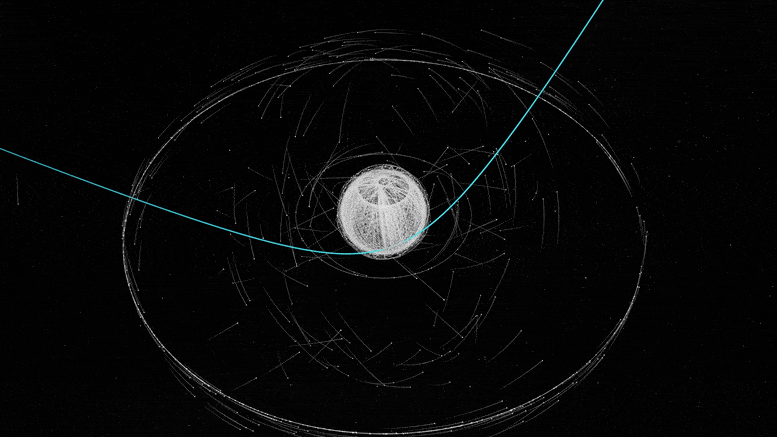
On October 16, 2022, NASA’s Lucy spacecraft will fly by the Earth for the first of three gravity assists. During the maneuver, Lucy will pass within 219 miles of the planet (lower than the International Space Station) and will fly through a cloud of over 6,200 Earth-orbiting satellites. This data visualization depicts Lucy’s trajectory through the satellite swarm. Credit: NASA’s Scientific Visualization Studio
Mission engineers will continually track NASA’s Lucy spacecraft as it prepares to swing by Earth on October 16 for a gravity assist. This will allow it to use this planet’s gravity to gain some of the orbital energy and set itself on a course toward the Jupiter Trojan asteroids.
However, that’s not all the engineers will be closely tracking. They will have to keep a look out for more than 47,000 satellites, debris, and other objects circling our planet. A greater than 1-10,000 chance that Lucy will collide with one of these objects, and mission engineers will be required to slightly adjust the spacecraft’s trajectory.
Although an adjustment is unlikely, and collisions are rare, NASA experts say the chances are increasing as the number of objects in Earth’s orbit grows.
The International Space Station (ISS), for example, has maneuvered out of the way of space debris 31 times since 1999, including three times since 2020.
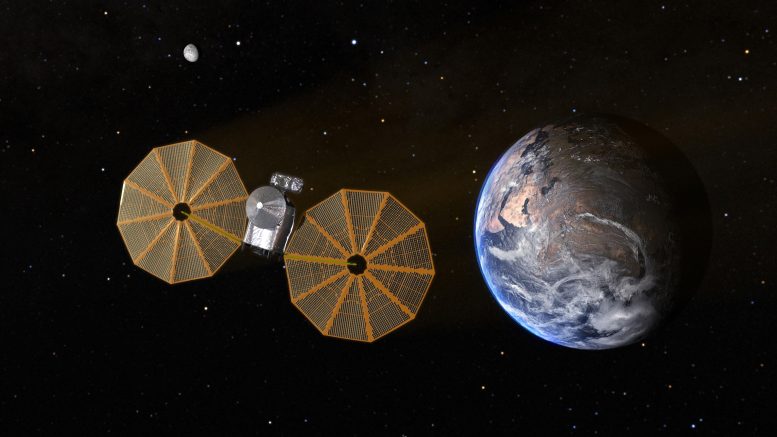
On October 16, 2022, Lucy will fly by the Earth like a partner in a swing dance, boosting its speed and elongating its orbit around the Sun. At 7:04 am, Eastern Time, Lucy will make its closest approach at just 219 miles above the planet: lower than the International Space Station. This exceptionally close shave will increase its velocity by four-and-a-half miles per second, setting Lucy on track to gain even more speed when it returns to Earth for its second gravity assist in December 2024. Credit: NASA’s Goddard Space Flight Center
“Low-Earth orbit is getting more crowded, so that has to be part of the consideration nowadays, especially for missions that fly low, like Lucy,” said Dr. Dolan Highsmith. He is chief engineer for the group that determines the probabilities of collisions between NASA’s robotic spacecraft and Earth-orbiting objects, the Conjunction Assessment Risk Analysis group at NASA’s Goddard Space Flight Center in Greenbelt, Maryland. NASA’s Johnson Space Center in Houston does the same for crewed spacecraft, including the space station.
Launched a year ago, on October 16, 2021, Lucy is on a 12-year-journey to study multiple Trojan asteroids up close. Discovered by German astrophotographer Max Wolf in February 1906, the Trojan asteroids are trapped in orbits around the Sun at the same distance as Jupiter. Lucy will be the first spacecraft to visit these remnants from the early solar system, helping scientists hone their theories on how the planets formed 4.5 billion years ago and why they ended up in their current configuration.
But Lucy has a long way to go before it arrives at the Trojans in 2027. The upcoming gravity assist is one of three the spacecraft will rely on to catapult itself to its deep-space targets.
On October 16, 2022, NASA’s Lucy spacecraft will fly by the Earth for the first of three gravity assists. During the maneuver, Lucy will pass within 219 miles of the planet (lower than the International Space Station) and will fly through a cloud of over 6,200 Earth-orbiting satellites. This data visualization depicts Lucy’s trajectory through the satellite swarm. Credit: NASA’s Scientific Visualization Studio
When Lucy comes nearest to Earth for its first gravity assist it will cruise 220 miles (350 km) above the surface. That’s lower than the altitude of the space station and low enough that the spacecraft will be visible with the naked eye from western Australia for a few minutes starting at 6:55 p.m. local time (10:55 UTC). On its way down, Lucy will fly through the most crowded layer of Earth’s orbit, which is monitored by the U.S. Space Force’s 18th Space Control Squadron. The squadron helps NASA identify close approaches.
Engineers began collision analysis for Lucy a week before the spacecraft’s Earth approach. Starting the process any earlier would render collision predictions futile, Highsmith said: “The further you’re predicting into the future, the more uncertain you are about where an object is going to be.”
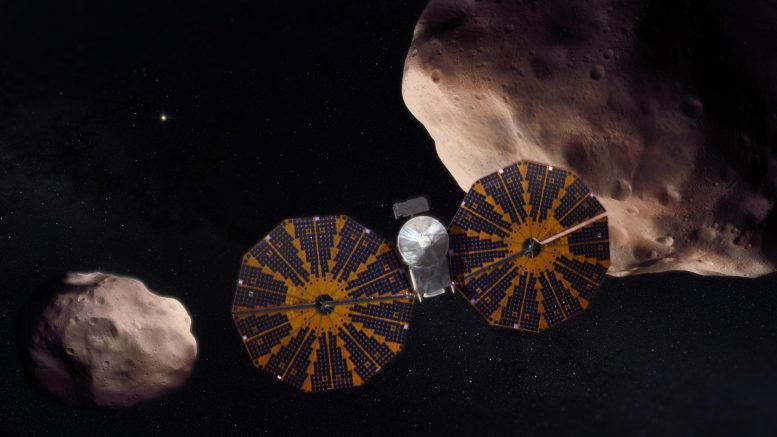
Lucy will explore the Jupiter Trojan asteroids – thought to be “fossils of planet formation.” Credit: NASA’s Goddard Space Flight Center
Determining the positions of spacecraft, plus orbiting satellites and debris, is challenging, particularly when trying to anticipate the future. Largely that’s because the Sun plays a major role in pulling or pushing objects around, and future solar activity is hard to predict. For example, the Sun’s activity — how much plasma and radiation it shoots out — affects atmosphere density, and thus how much friction will tug on a spacecraft and slow it down.
So the closer the collision assessment is to the Earth flyby time, the better. NASA sends Lucy’s whereabouts to the Space Force squadron daily. If the squadron determines that Lucy could intersect with something, Highsmith’s group will calculate the probability of a collision and work with the mission team to move the spacecraft, if necessary.
Ride-along view of Lucy’s first Earth gravity assist (EGA). The camera follows Lucy as the spacecraft approaches the sunlit side of Earth before crossing into Earth’s shadow as it slingshots around the planet. This is a slower version of the full ride along view above, focusing on the approach. Credit: NASA’s Scientific Visualization Studio
“With such a high-value mission, you really need to make sure that you have the capability, in case it’s a bad day, to get out of the way,” Highsmith said.
Lucy navigation engineers have two maneuver options ready in case the spacecraft needs to avoid an object. Both maneuvers require engine burns to speed up the spacecraft, which is traveling about 8 miles (12 km) per second. Each maneuver can move Lucy’s closest approach to Earth up by 2 seconds or 4 seconds, respectively.
“That’s enough to avoid any one thing that could be in the way,” said Kevin E. Berry, Lucy’s flight dynamics team lead from NASA Goddard.
Hal Levison of Southwest Research Institute (SwRI), in the Boulder, Colorado, office, is the principal investigator. SwRI, headquartered in San Antonio, also leads the science team and the mission’s science observation planning and data processing. NASA Goddard provides overall mission management, systems engineering, and the safety and mission assurance for Lucy. Lockheed Martin Space in Littleton, Colorado, built the spacecraft and is providing flight operations. Goddard and KinetX Aerospace in Simi Valley, California, are responsible for navigating the Lucy spacecraft. Lucy is the 13th mission in NASA’s Discovery Program, which is managed by NASA’s Marshall Space Flight Center in Huntsville, Alabama.

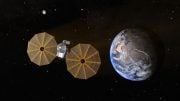
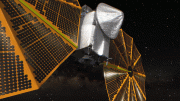

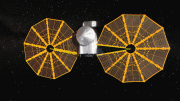
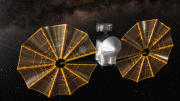
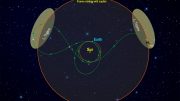
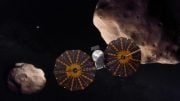
Be the first to comment on "Never Tell Me the Odds: NASA’s Lucy To Fly Past Thousands of Objects for Earth Gravity Assist"